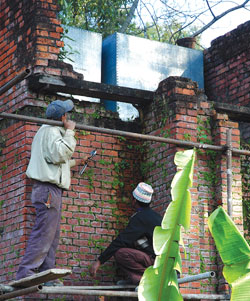|
|
In most parts of the world, hepatitis E afflicts the poor, those who don't have access to safe drinking water.
But in Nepal, the virus attacks everyone: from prime minister to slum-dweller. Girija Prasad Koirala is showing symptoms of jaundice, and it is likely to be a hepatitis E infection caused by contaminated water. Five members of the cabinet have it, and the foreign minister was hospitalised for over a month. A senior Kathmandu-based foreign diplomat also recently came down with hepatitis E.
Hepatitis E is a neglected, viral illness spread primarily when drinking water is contaminated with faeces. Kathmandu's leaky mains are susceptible to contamination and the water supply here is endemic for hepatitis E outbreaks.
Initial symptoms may be nausea, loss of appetite, abdominal pain, tiredness, itching, and some fever. When the eyes turn yellow, the person actually begins to feel better and the fever subsides. The illness may last from about a week to a month and the jaundice usually completely clears in two to six months.
The other common hepatitis in Nepal, hepatitis A, is also transmitted faeco-orally and has the same symptoms as hepatitis E. But person-to-person transmission of hepatitis E is only up to two percent, compared to over 50 percent with hepatitis A. This suggests that a larger dose ('inoculum' in medical parlance) may be necessary for the transmission of hepatitis E, in comparison to the A virus. To get the E virus, you may have to drink an entire glass of Bishnumati water-which may prove that in case of the present outbreak the Baluwatar mains have massive sewage contamination.
The large inoculum theory is supported by the fact that tourists who are here for a short time and are very careful regarding drinking water usually suffer significantly less from hepatitis E than A, although this may also be changing as tourists obtain hepatitis A vaccine. There is no need to isolate the patient, washing hands with soap and water after going to the bathroom is adequate. The infection is not transmitted sexually or through blood, unlike viral hepatitis B, C, and D.
Hepatitis E seems to be more common in the urban than rural areas, probably due to worse water contamination in cities. Almost everyone over the age of 10 who grew up in Nepal has had at least a full blown or subclinical infection with hepatitis A, thanks to our poor public health safeguards. But the good news is this initial infection guarantees lifelong immunity with protective antibodies. Unfortunately prior infection with hepatitis E doesn't prevent us from being reinfected with the E virus. Although the infection is debilitating, it doesn't usually kill most patients. It is, however, dangerous for pregnant women-hepatitis E kills up to 30 percent of pregnant women afflicted with the disease.
 |
| DON\'T DRINK THE WATER: Baluwatar\'s water tanks get ready for a much-needed cleaning, but it comes too late for the politicians who have already contracted hepatitis. |
The treatment for this disease is symptomatic, that is, nothing in particular. There is no need for strict bed-rest. The appetite is usually so poor that more restrictions on food are not advisable. Alcohol is best avoided while the liver recovers.
Evidence suggests that the reservoir for the virus may be domestic swine or people with subclinical infection. The single most important preventive measure is clean drinking water. The good news is, a hepatitis E vaccine may soon be available, which may especially be important for women before pregnancy.
Buddha Basnyat, MD, is with the Nepal Health Research Council and is a consultant at Patan Hospital.
Hepatitis E: Prevention better than cure
. Drink only boiled water
. Eat hot foods, avoid salads when eating out
Symptoms:
Nausea
Loss of appetite
Abdominal pain
Tiredness
Itching
Fever



